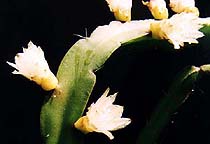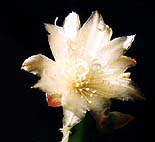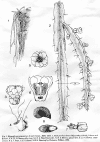Pfeiffera
paranganiensis
(Cardenas.) Barthlott in Bradleya 5; 99 (1987) Lepismium paranganiense
(Cardenas.) Barthlott in Bradleya 5; 99 (1987) Stems
- at first erect to arching, finally pendent, branching
freely, to 4 m long, ca. 12 mm thick, the sides slightiy to strongly
concave; ribs (2-) 4 (-5), obtusely serrate, sharp-margined; The
stems of R.
paranganiensis are
nearly erect when young but eventually arch over and become pendent.
Although Cardenas' photographs show many flowers along each stem, they
have appeared rather sparsely under our cultivation; they have also
rarely formed fruit unless hand-pollinated with pollen of another clone. Notes from Bradleya
13 DISTRIBUTION.
Bolivia (Cochabamba): terrestrial or epilithic, at 2600-3000 m altitude. In
the Kew Herbarium there is a photograph of this species taken by Cardenas
in 1935, in the region of the type locality, at 3000 m altitude, where
it would appear to be terrestrial. It is easy to cultivate, but some
clones never flower when planted in a hanging basket, perhaps because
it prefers a terrestrial habitat where at least some of its stems can
grow erect. A plant recently collected at the type locality has flowered
in Bonn with large creamy-yellowish flowers. One particular collection
by Friedrich Ritter (FR 343) differs significantly in having flowers
with many (up to 15) brilliant white perianth-segments. Photos,
copyright Derek Butcher.
Desc from CSJ(US) p210 (1984)
Areoles - 2.5 - 4 cm
apart, subtended by an appressed, obtuse, mucronate, amber-yellowish
green leaflet less than 1 mm long and wide; areolar wool-mass cream,
ca. 1 mm wide;
Spines - at right angles
to stem or nearly parallel to it, sharp, yellowish tan, 1-4, about two
of them sinuous, thinner and 4-5 mm long, the other 1 or 2 straight
and 7 - 10 mm long;
Epidermis - smooth,
slightly shiny, green.
Flowers - single, 17 - 20 mm long, the limb 18 -22 mm wide;
Receptacle - 6-7
mm long, 9-10 mm thick near apex, purphsh green, the podaria 4 -
5 mm long, ca. 4 mm wide, obtuse to subacute;
Bracteoles - appressed, obtuse to acute, 1 - 1.5 mm long and wide,
subtending areolar wool less than 1 mm long and 2 - 4 hair-like yellowish
spines to 2 mm long;
Outer tepals - ovate to obovate, 3 - 11 mm long, 3 - 7 mm wide, obtuse,
mucronate, yellowish, with
reddish
magenta apices;
Inner
tepals
- oblong-ovate,
obtuse, slightly mucronate, 12 - 15 mm long, 6 - 8 mm wide, cream, the
apex reddish;
Nectaries
-
forming
a yellow torus-like ring near base of style;
Stamens
- inserted
in a single zone around the nectaries, the filaments ca. 10 mm long,
yellowish, the anthers ca. 0.25 mm long, yellow;
Style
- ca.
7 mm long and 1 mm thick, cream, the stigma with 6 - 8 recurving lobes
2 - 3 mm long and ca. 1 mm thick, cream. Fruit
- turbinate-globose,
8 mm long, 10 mm thick, abruptly tapered near the base, the apex 7 mm
wide, umbilicate, the depression ca. 1 mm deep; podaria ca. 7, prominent,
usually as long as fruit, obtuse to subacute, 3 - 7 mm long, ca. 4 mm
wide, the epidermis brownish yellow with a faint greenish tinge;
Bracteoles
-
slightly
expanding, widely ovate to deltoid, less than 1 mm long; dried remains
of flower erect, 1 cm long, brownish yellow.
Seeds
- comma-shaped
(obovate, with a highly oblique hilum), 1.75 mm long, 1 mm wide, 0.5
mm thick, the testa minutely pitted, shiny, dark reddish brown, the
hilum highly oblique, somewhat sunken, white, with a black beak-like
projection near seed-apex.


